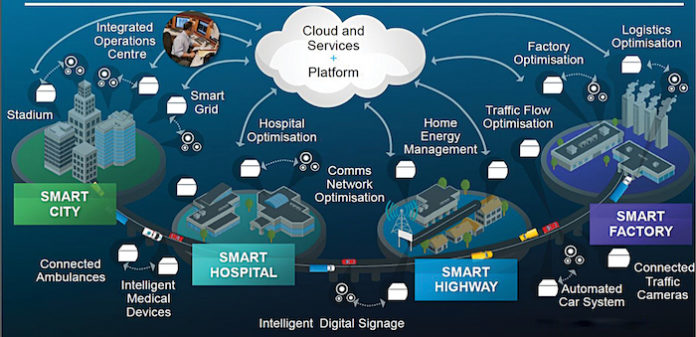The Internet of Things (IoT) offers new opportunities for cities to use data to manage traffic, cut pollution, make better use of infrastructure and keep citizens safe.
Tularam M. Bansod is proprietor of TMB Enterprises, a startup focussed on embedded systems domain. He has authored two books on microcontroller programming
Jitu’s mother says, “Jitu, please call for an air taxi. We need to go to Connaught Place urgently for shopping.” Jitu fiddles with his cellphone and the apps installed on it to book an air taxi. He then receives an alert message from Smart Waste Container Truck to deposit dustbins from his housing society. Jitu takes care of it immediately—he is a young social worker at his housing society. He downloads Clean City app from New Delhi
Municipal Council’s website and configures the location of his housing society in that app. Immediately, it displays the current pollution level as PM1.5 in Jitu’s area.
Jitu says, “Mom, I will give a command to the smart dustbin to coordinate with the truck that will soon be here.”
The above happens in New Delhi in the year 2028, when New Delhi has become a smart city. But how can New Delhi become smart without the Internet of Things (IoT) technologies? A smart city is defined as a city that connects its physical, ICT, social and business infrastructures to leverage the collective intelligence of the city.
A city cannot become smart without the interconnection of utilities like energy, transport and ICT, waste and water supply management, connected hospitals and blood banks, connected homeland security and schools, among others.

These connections are made possible by the various layers of the IoT. There are three layers in the IoT. First is the application layer that processes, collects and displays data in various formats.
Second layer is the network layer that forwards IoT packets over reliable communication networks.
Third layer is the perception layer that gathers, captures, identifies and distinguishes information of the different objects in the physical world. This layer consists of sensors, cameras, RF tags, GPS, laser scanners and so on.
The IoT introduces new methods to capture live data and to send the same to a server or cloud. This helps with the monitoring of remote devices and decision-making on remotely-captured information. The IoT products improve traffic management in cities, so that roads can become intelligent and recognise the number of vehicles on it.
To use a particular technology, it is important to understand and identify the requirements of that technology. The IoT platforms connect multiple heterogeneous systems in a city.
For example, pediatric wards of hospitals in a city can be connected to schools to get health data of children. And based on this data, grants can be distributed.
We have seen that e-commerce has become extremely successful in India because Internet services have become cheaper. A ` 5 phone recharge has created growth for many e-services. Similarly, cheaper IoT services can help create connected smart cities.
A city has multiple concrete structures that can be monitored by putting passive wireless sensors in the structures. Periodically, radio signals are emitted from building structures that can be accumulated by the city municipal corporation. The figure shows a highly-connected future smart city.
The IoT helps keep a watch on water levels of dams, lakes, sewage and the like. Water leakage must be sensed immediately for proper usage of water.
Waste management has become a major problem in urban cities. In smart cities, IoT devices attached to garbage containers send alerts when their capacity has been exhausted and, accordingly, garbage collector trucks pick up such garbage containers. LPWAN technology can be used for this purpose.
Wireless patient monitoring systems are needed in hospitals. Here, passive and active sensors can be placed on the patients to monitor their physiological parameters. The sensors remain with the patients till the time they are discharged from the hospital. Highly-secure IoT systems must be created in compliance to privacy laws.
A smart grid is needed in every city. Intelligent power controllers have already been designed, and smart e-meters are being used to read consumption of electricity. The IoT is already playing a great role in cost-effective power generation, distribution and transmission.
Companies like Google, Uber, Renault, Ford and Volvo are developing autonomous vehicles. Driverless cars are a key component of connected smart cities. Air taxis will soon become common in ultra-smart cities.
IBM Bluemix is a platform for Infrastructure as a Service (IaaS) for smart cities. AirVantage is a machine-to-machine (M2M) connectivity platform to connect IoT objects. Nokia and Cisco are developing many connected smart city IoT platforms.
Tularam M. Bansod is proprietor of TMB Enterprises, a startup focussed on embedded systems domain. He has authored two books on microcontroller programming.








